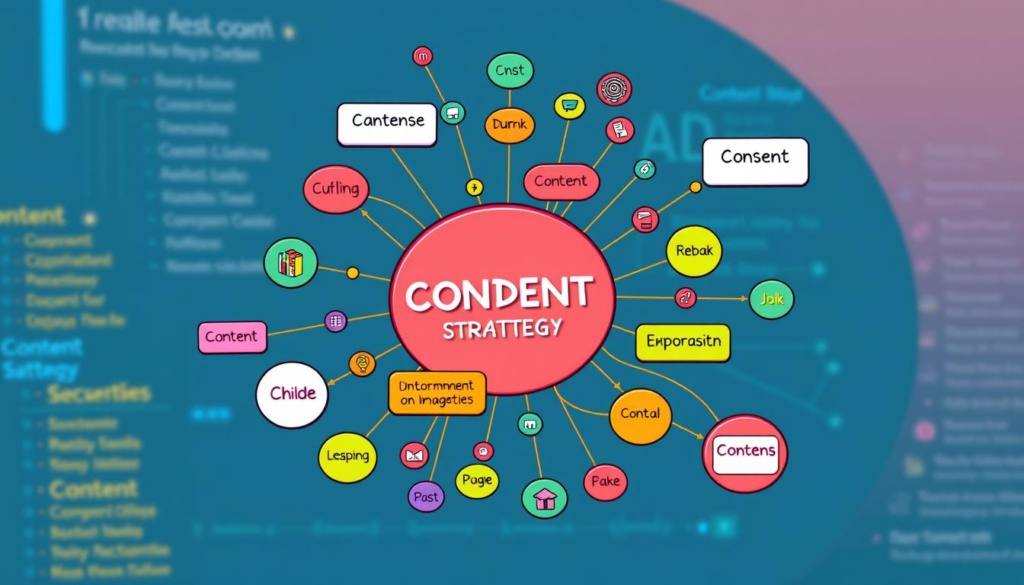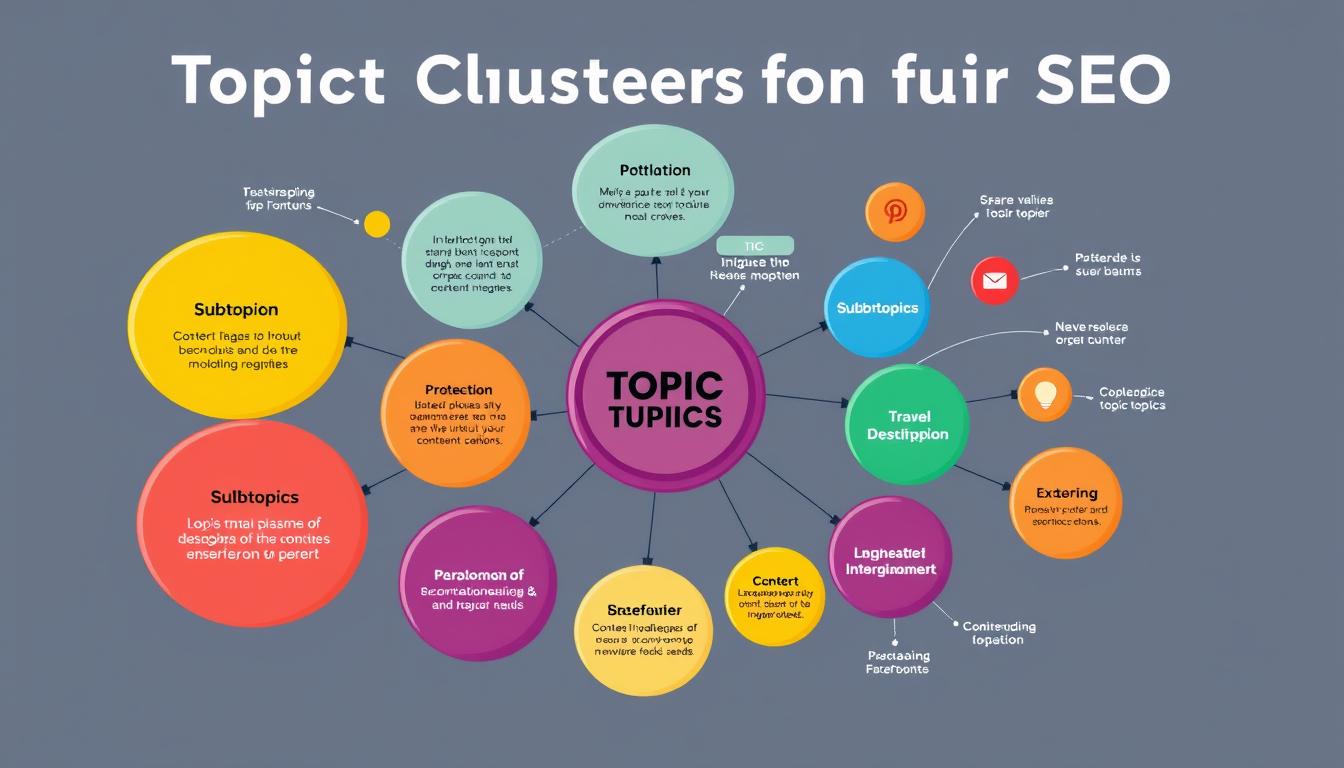Search engine optimization (SEO) is changing fast. Content strategy is key for businesses to be seen online. Topic clusters are a big part of this strategy. They help your content rank better and make it easier for users to find what they need1.
Topic clusters have a main page that talks about a big topic. Then, there are smaller pages that talk about related topics. This makes it easy for search engines to see how your content is connected. It also gives users all the info they need21.,
Using topic clusters can really help your website. It can make your site more visible, important, and get more visitors1. This way of organizing content makes it better for search engines and users. It helps your business grow by getting more people to take action.
Key Takeaways:
- Topic clusters are a powerful SEO strategy that organizes content around a central theme.
- Pillar pages cover broad topics in-depth, while cluster pages focus on related subtopics.
- This structured approach helps search engines understand content relationships and context.
- Implementing topic clusters can significantly improve website visibility, authority, and organic traffic.
- A well-designed topic cluster strategy delivers a seamless user experience and drives conversions.
What Are Topic Clusters and Why They Matter
In the world of search engine optimization (SEO), topic clusters are key. They help make your content easier to find and understand. A pillar page is the main page, and cluster pages are the related ones. This makes your website’s information clear to search engines3.
Definition of Topic Clusters
Topic clusters organize your content in a special way. You have a main page that covers a big topic. Then, there are smaller pages that dive deeper into that topic. This helps search engines see how good your content is, which can make your site more visible3.
Benefits of Implementing Topic Clusters
- More people will stay on your site and find what they need, making for a better experience3.
- Search engines will understand your content better, thanks to semantic SEO3.
- Your site’s structure will be clearer, helping search engines find your content easier3.
- You’ll be seen as a reliable source of information, boosting your topical authority3.
- More people will do what you want them to do, like buy something or sign up, because they can find what they need3.
Using topic clusters well can really help your site. You’ll see better rankings, more people staying on your site, and a better user experience3.
The Pillar-Cluster Model Explained
In SEO and content strategy, the pillar-cluster model is key. It makes your website architecture better. It helps users find what they need and helps search engines too.
Understanding Pillar Content
Pillar content is at the core of this model. Pillar pages are detailed guides on big topics. They have at least 2,000 words4.
These pages are like main hubs. They link to cluster pages that go into subtopics.
Key Features of Cluster Content
Cluster content dives deep into subtopics of the main topic. These pages offer lots of info and insights5. Linking pillar pages to cluster content makes your site better for users and search engines.
Pillar pages can be many things. They can be 10X content, resource pages, or subtopic pages5. Each type has its own role in your content strategy.
Using the pillar-cluster model makes your website architecture strong. It makes your site better for users and search engines. This can bring more traffic and sales to your site45.
How to Identify Relevant Topics for Clusters
Creating a good content plan for your site needs to know your audience well. Look at keyword research and audience insights to find the best topics for your SEO clusters6.
Analyzing Keyword Research
Begin with keyword research using Google Trends and Google Keyword Planner. These tools show you what people search for and what’s new in your field7. Then, check your current content to see what’s missing. This helps you find new topics that will attract more visitors and keep them interested.
Leveraging Audience Insights
Knowing what your audience wants is crucial for picking the right topics. Look at your buyer personas, what customers say, and what’s happening in your industry6. This way, you can make content that speaks to them and makes your brand a go-to in your field.

“Successful topic clusters are built upon a deep understanding of your target audience and their search behavior. Invest the time to uncover the most relevant and valuable topics for your content strategy.”
By mixing keyword research with knowing your audience, you find the best topics for your clusters. This smart method makes sure your content ranks well and is truly helpful to your readers67.
Structuring Your Topic Clusters Effectively
Making a strong website and content plan is key. It helps users and search engines find what they need. Topic clusters are at the center of this, connecting content around a main page8.
Best Practices for Organizing Content
Begin by picking a main page that covers the topic well. This page is the base for your cluster pages. They go deeper into subtopics8.
Arrange your cluster pages in a clear order. Make sure they link back to the main page smoothly. This makes for a better user experience8.
Internal Linking Strategies
Creating a smart internal link plan is important. Link your cluster pages to the main page and back. This helps both search engines and users find their way8.
Don’t link too much. Instead, make links that make sense and help your site’s structure and user experience8.
“Effective topic cluster structure involves organizing content logically around a central theme, with a strong pillar page that comprehensively covers the main topic and cluster pages that dive deeper into specific aspects.” –8
Follow these tips for better content organization and internal linking. This will make your website easy to use and improve your SEO910.
Optimizing Your Content for SEO
Making great content for your topic clusters needs a smart plan for SEO. Use the right keywords and make good meta tags and descriptions. This makes your content show up better in search results.
Importance of On-Page SEO
On-page SEO is about making your web pages better for search engines. Use the right keywords in your titles, headings, and text11. ChatGPT can help with keywords, writing, and getting ideas11.
It can also sort keywords by what people are searching for11.
Utilizing Meta Tags and Descriptions
Good meta titles and descriptions are key for more clicks from search results. They should show what your content is about and why it’s worth visiting11. ChatGPT can make these for you, helping your content get seen more11.
| SEO Tool | Key Features |
|---|---|
| Ahrefs | Comprehensive SEO tool covering on-page, off-page, site audits, and more12. |
| Keyword Tool | Specializes in finding the best SEO keywords to target12. |
| Exploding Topics | Performs trend analysis to identify soon-to-be-popular topics12. |
| WordStream Free Keyword Tool | Provides unlimited keyword research for SEO12. |
| Animalz Revive | Refreshes SEO content for improved ranking12. |
Use these SEO tips and AI tools to make your content better. This will help it show up more in search results and get more people to visit.
Examples of Successful Topic Clusters
Using topic clusters well can really help your content strategy. Companies like HubSpot and Moz are great examples of this.
Case Study: HubSpot
HubSpot changed the game with their inbound marketing topic cluster13. They use semantic SEO to understand what users want13. This makes their content very relevant and useful13.
They also use lots of multimedia like videos and images13. This makes their site more interesting and helps with SEO13.
Case Study: Moz
Moz became a big name with their “Beginner’s Guide to SEO” topic cluster14. They know what users are looking for and make content that meets their needs14.
They focus on making pillar content with the right keywords14. This makes their SEO resources easier to find14.
Moz also sets clear goals and tracks their success14. This helps their topic cluster strategy work well14.
These examples show how topic clusters can help with visibility, engagement, and sales for content strategy, SEO case studies, and content marketing. Learning from these can help improve your own content strategy.

“Successful topic cluster implementation can significantly improve search rankings and organic traffic.”
Measuring the Success of Your Topic Clusters
It’s key to check how well your topic clusters are doing. This helps make your content better and your SEO work pay off. By looking at SEO metrics, data, and how people use your content, you learn a lot. This helps you make your topic clusters even better.
Key Metrics to Track
Watch your organic traffic, search rankings, and how many people click on your content15. Also, see how long people stay on your pages and if they leave quickly15. Looking at how people move through your content can also tell you a lot15.
Tools for Data Analytics
Use tools like Google Analytics, Google Search Console, and SEO platforms for deep analysis16. These tools show you how your keywords are doing and where you need more content16.
Also, use tools like Grammarly and Hemingway to check if your content is easy to read16. Update your content often to keep it interesting and engaging for your audience.
| Tool | Key Capabilities |
|---|---|
| Google Analytics | Provides insights into user behavior, traffic sources, and content performance16. |
| Google Search Console | Offers data on keyword rankings, impressions, and search visibility16. |
| Semrush, Ahrefs, Moz | Analyze website SEO performance, keyword rankings, backlinks, and search visibility16. |
| Hotjar, Crazy Egg | Provide heatmaps, session recordings, and insights into user interaction with website content16. |
| Grammarly, Hemingway | Identify and rectify content grammar, spelling, and readability issues16. |
By using these tools and checking your data analytics often, you can make smart choices. This helps you improve your topic clusters and keep your content strategy working well for your business.
Common Mistakes to Avoid
Building good topic clusters is key to a strong content plan. But, it’s easy to make mistakes. One big mistake is not thinking about what users want when we make content17. We must really get what our audience is looking for and make our content match17.
Another mistake is forgetting to keep content up to date. Search engines and what people like change all the time. So, we must keep our topic clusters new and interesting18. If we don’t, our rankings can drop and users might not like our site as much18.
- Avoid making pillar pages that are too wide or too narrow. They should help your cluster content well.
- Watch out for too many internal links. They can confuse both users and search engines.
- Don’t forget about making your site work well on phones. It’s important for both users and SEO.
By avoiding these common errors, you can make a content plan that really speaks to your audience and helps your business grow17. Always be careful and keep improving your strategy. This way, your topic clusters will stay a strong part of your SEO plan18.
“Successful topic cluster strategies require constant monitoring and optimization to maintain their effectiveness.”
Future Trends in Topic Clusters for SEO
Search engine optimization is always changing. The future of topic clusters will include semantic SEO and voice search optimization19. Semantic search is big because it looks at what users really want, not just keywords20. It makes your content better by linking it all together.
Artificial intelligence and machine learning help make your topic clusters better. They guess what people want and make your content fit their needs.
The Rise of Semantic Search
Search engines are getting smarter. They now focus on what you really mean, not just what you type20. Your topic clusters need to cover more and be deeper.
This means your content must meet the user’s needs. By doing this, your content will be more relevant and useful. This helps you show up better in searches and keeps users interested.
Integrating Voice Search Optimization
Voice-activated devices are becoming more common. Voice search optimization is key for your topic clusters21. People ask questions or use long-tail keywords when they search by voice.
Make your topic clusters answer these questions. This will help you reach more people using voice search20. Your content should be clear and answer questions directly. This makes your brand more trusted in your field.
FAQ
What are topic clusters?
Topic clusters are a way to organize content. They have a main page and smaller pages that link to it. This makes it easy for search engines and people to find what they need.
What are the benefits of implementing topic clusters?
Using topic clusters can make your website more visible and useful. It helps more people find your site and stay longer. It also makes your site easier to use and understand.
What are the key components of the pillar-cluster model?
The model has a main page and smaller pages. The main page gives a broad overview. The smaller pages go into more detail. This makes it easy to find what you need.
How do you identify relevant topics for your topic clusters?
First, know who you’re talking to. Then, find keywords that people search for. Look at what’s already out there to see what’s missing.
What are the best practices for structuring topic clusters?
Start with a main page that covers everything. Then, make smaller pages for details. Use links to connect everything. But don’t link too much.
How do you optimize topic cluster content for SEO?
Use the right keywords in your content. Make your titles and descriptions catchy. Use schema markup and write in a friendly way.
What are some examples of successful topic cluster implementation?
Companies like HubSpot and Moz have seen big improvements. Their topic clusters have brought in more visitors and better rankings.
How do you measure the success of your topic clusters?
Look at traffic, rankings, and how people interact with your site. Check how well your links work. Update your content based on what works.
What are some common mistakes to avoid when implementing topic clusters?
Don’t forget about what people are looking for. Keep your content fresh. Make sure your main page is broad but focused. Don’t link too much. And make sure your site works on phones.
How will topic clusters evolve in the future of SEO?
Topic clusters will change with new search trends. Use AI to improve your strategy. Keep up with new search engine rules to stay ahead.




